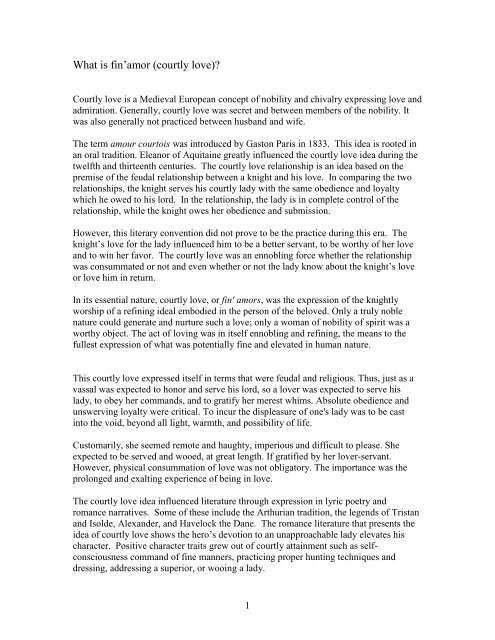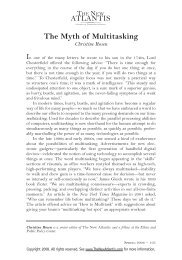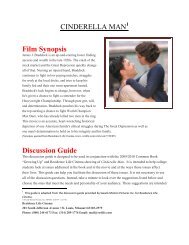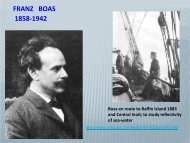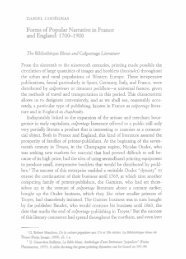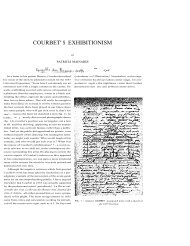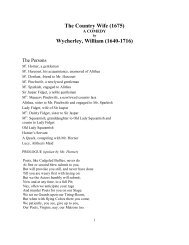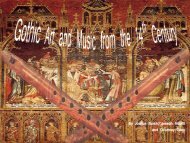What is fin'amor (courtly love)
What is fin'amor (courtly love)
What is fin'amor (courtly love)
Create successful ePaper yourself
Turn your PDF publications into a flip-book with our unique Google optimized e-Paper software.
<strong>What</strong> <strong>is</strong> fin’amor (<strong>courtly</strong> <strong>love</strong>)?<br />
Courtly <strong>love</strong> <strong>is</strong> a Medieval European concept of nobility and chivalry expressing <strong>love</strong> and<br />
admiration. Generally, <strong>courtly</strong> <strong>love</strong> was secret and between members of the nobility. It<br />
was also generally not practiced between husband and wife.<br />
The term amour courto<strong>is</strong> was introduced by Gaston Par<strong>is</strong> in 1833. Th<strong>is</strong> idea <strong>is</strong> rooted in<br />
an oral tradition. Eleanor of Aquitaine greatly influenced the <strong>courtly</strong> <strong>love</strong> idea during the<br />
twelfth and thirteenth centuries. The <strong>courtly</strong> <strong>love</strong> relationship <strong>is</strong> an idea based on the<br />
prem<strong>is</strong>e of the feudal relationship between a knight and h<strong>is</strong> <strong>love</strong>. In comparing the two<br />
relationships, the knight serves h<strong>is</strong> <strong>courtly</strong> lady with the same obedience and loyalty<br />
which he owed to h<strong>is</strong> lord. In the relationship, the lady <strong>is</strong> in complete control of the<br />
relationship, while the knight owes her obedience and subm<strong>is</strong>sion.<br />
However, th<strong>is</strong> literary convention did not prove to be the practice during th<strong>is</strong> era. The<br />
knight’s <strong>love</strong> for the lady influenced him to be a better servant, to be worthy of her <strong>love</strong><br />
and to win her favor. The <strong>courtly</strong> <strong>love</strong> was an ennobling force whether the relationship<br />
was consummated or not and even whether or not the lady know about the knight’s <strong>love</strong><br />
or <strong>love</strong> him in return.<br />
In its essential nature, <strong>courtly</strong> <strong>love</strong>, or fin' amors, was the expression of the knightly<br />
worship of a refining ideal embodied in the person of the be<strong>love</strong>d. Only a truly noble<br />
nature could generate and nurture such a <strong>love</strong>; only a woman of nobility of spirit was a<br />
worthy object. The act of loving was in itself ennobling and refining, the means to the<br />
fullest expression of what was potentially fine and elevated in human nature.<br />
Th<strong>is</strong> <strong>courtly</strong> <strong>love</strong> expressed itself in terms that were feudal and religious. Thus, just as a<br />
vassal was expected to honor and serve h<strong>is</strong> lord, so a <strong>love</strong>r was expected to serve h<strong>is</strong><br />
lady, to obey her commands, and to gratify her merest whims. Absolute obedience and<br />
unswerving loyalty were critical. To incur the d<strong>is</strong>pleasure of one's lady was to be cast<br />
into the void, beyond all light, warmth, and possibility of life.<br />
Customarily, she seemed remote and haughty, imperious and difficult to please. She<br />
expected to be served and wooed, at great length. If gratified by her <strong>love</strong>r-servant.<br />
However, physical consummation of <strong>love</strong> was not obligatory. The importance was the<br />
prolonged and exalting experience of being in <strong>love</strong>.<br />
The <strong>courtly</strong> <strong>love</strong> idea influenced literature through expression in lyric poetry and<br />
romance narratives. Some of these include the Arthurian tradition, the legends of Tr<strong>is</strong>tan<br />
and Isolde, Alexander, and Havelock the Dane. The romance literature that presents the<br />
idea of <strong>courtly</strong> <strong>love</strong> shows the hero’s devotion to an unapproachable lady elevates h<strong>is</strong><br />
character. Positive character traits grew out of <strong>courtly</strong> attainment such as selfconsciousness<br />
command of fine manners, practicing proper hunting techniques and<br />
dressing, addressing a superior, or wooing a lady.<br />
1
Boase, Roger. The Origin and Meaning of Courtly Love. Manchester University<br />
Press: Oxford Road, Manchester, 1977. Print.<br />
Burns, Jane E. “Speculum of the Courtly Lady: Women, Love, and Clothes.” Journal of<br />
Medieval and Early Modern Studies 29 (1999): 253-292. Web.<br />
Heale, Elizabeth. “Women and the Courtly Love Lyric: The Devonshire MS (BL<br />
Additional 1749).” The Modern Review 90 (1995): 296-313. Web.<br />
Shirt, David J. “’Le Chevalier de la Charrete: A World Upside Down?.’” The Modern<br />
Language Review 76 (1981): 811-822. Web.<br />
Stone, Gregory L. “Chretien de Troyes and Cultural Material<strong>is</strong>m” Arthuriana 6 (1996):<br />
69-87. Web.<br />
2


